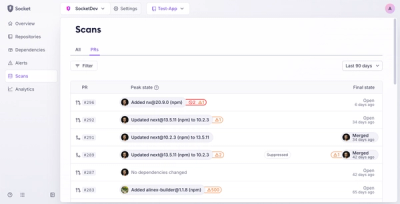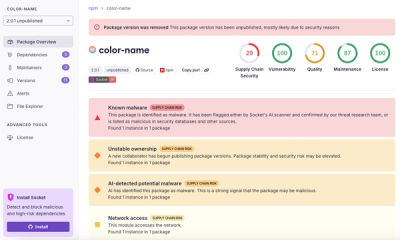
Security News
MCP Steering Committee Launches Official MCP Registry in Preview
The MCP Steering Committee has launched the official MCP Registry in preview, a central hub for discovering and publishing MCP servers.
phantomstream
Advanced tools
Write and automate PhantomJS scripts inside node, using a standard Stream interface.
First off, install the phantomstream module.
npm install phantomstream
Next, create a simple script named "myscript.js".
phantomstream = require("../phantomstream")
// Open up a PhantomJS stream that listens for commands that look like
// "TITLE <url>". Browse to the URL and write the title back via the stream.
var conf = {logger: console}
var ps = phantomstream.open(conf, function(nodestream, phantom, require, global) {
// This callback executes inside of PhantomJS, not node. To see the API
// available to you in PhantomJS, check out their documentation:
// http://code.google.com/p/phantomjs/wiki/Interface
var page = require("webpage").create()
// Listen for the "TITLE <url>" commands via the streaming interface.
nodestream.on("data", function(data) {
var matches = /TITLE\s*(.+)/.exec(data)
if (matches) {
var url = matches[1]
// Got a TITLE command, use the PhantomJS page object to browse
// to that page, get the document title, and write it back to the stream.
console.info("opening", url)
page.open(url, function() {
var title = page.evaluate(function() {
return document.title
})
console.info("sending title =", title)
nodestream.write(title)
})
}
})
})
// Send an TITLE command to our PhantomJS process and echo the response.
ps.write("TITLE http://www.google.com")
ps.on("data", function(data) {
console.info("node received:", data.toString())
process.exit()
})
Run your script with node.
node myscript.js
...you should see output like this:
[phantom-stdout] opening http://www.google.com
[phantom-stdout] sending title = Google
node received: Google
Enjoy! For more ideas on what is possible inside the callback for
phantomstream.open(), read the
PhantomJS documentation.
Don't forget try out some demos from the examples/ directory :)
If you are looking for higher-level implementations that wrap the PhantomJS API, check these out:
FAQs
Streaming interface to the PhantomJS headless browser
The npm package phantomstream receives a total of 1 weekly downloads. As such, phantomstream popularity was classified as not popular.
We found that phantomstream demonstrated a not healthy version release cadence and project activity because the last version was released a year ago. It has 1 open source maintainer collaborating on the project.
Did you know?

Socket for GitHub automatically highlights issues in each pull request and monitors the health of all your open source dependencies. Discover the contents of your packages and block harmful activity before you install or update your dependencies.

Security News
The MCP Steering Committee has launched the official MCP Registry in preview, a central hub for discovering and publishing MCP servers.

Product
Socket’s new Pull Request Stories give security teams clear visibility into dependency risks and outcomes across scanned pull requests.

Research
/Security News
npm author Qix’s account was compromised, with malicious versions of popular packages like chalk-template, color-convert, and strip-ansi published.